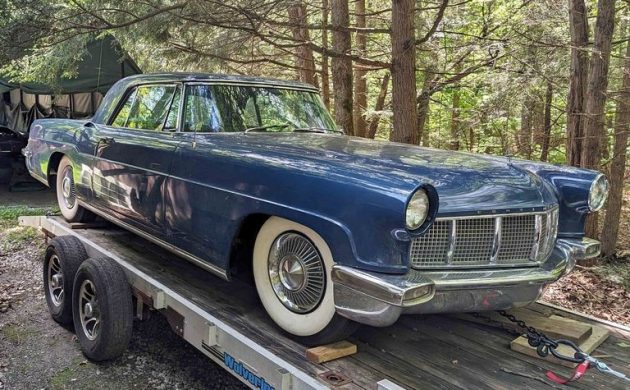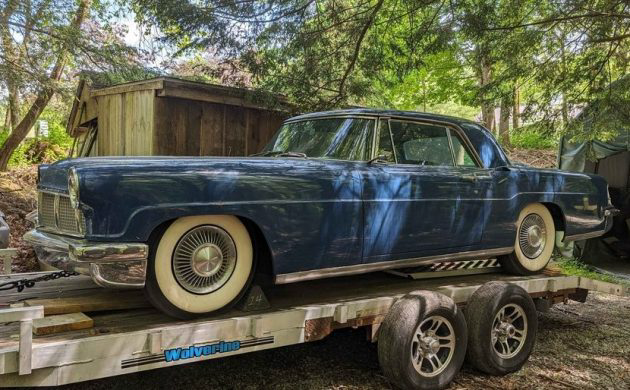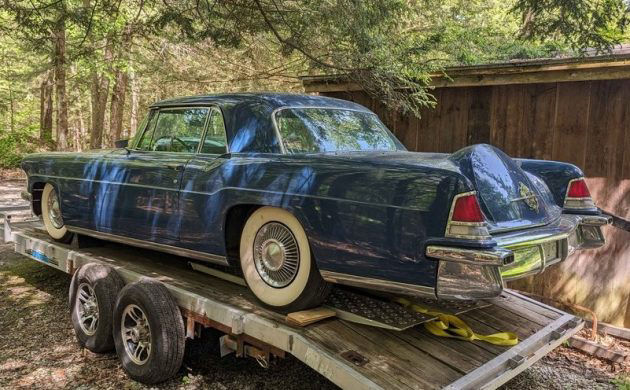Henry Ford II was renowned for making bold choices, and these often set him on a collision course with others. However, none produced a more profound impact on his family than his decision to merge the company’s Continental Division with Lincoln. William Clay Ford invested enormous time and effort into Continental, the only part of the Ford empire that held any attraction for him. This action caused an estrangement between the siblings that never fully healed. This 1956 Continental Mark II emerged from the factory during those heady days and sat in storage for over thirty years. Its exterior presentation is quite impressive, and it could be an excellent restoration candidate. It is ideal for someone seeking a classic created by its manufacturer following a “money is no object” approach, and I must say a big thank you to Barn Finder Paul in MA for spotting this excellent project candidate.
Ford created the Continental Division in 1956 as an exercise in pure excellence. The aim was to produce the world’s best luxury production car, giving marques like Rolls-Royce a run for their money. Sadly, the exercise would be short-lived, with the company absorbing Continental into the Lincoln brand to cut costs and satisfy investors following Ford’s sharemarket float. It is hard to convey how intently Continental focused on perfection, but the wheel covers for the Mark II probably demonstrate this perfectly. Most companies stamped these out of steel, adding chrome or paint as embellishment. The Mark II featured handmade items where the inner and outer sections were separate assemblies, with the pair attached via vanes that were bolted together by a technician. A traditional hubcap took mere minutes to make, but those on the Continental took nearly an hour each. It is no wonder that the Mark II was America’s most expensive production car when it emerged from the factory. It is more amazing that even though the price was unprecedented, Ford lost nearly $1,000 on each sold Mark II. The seller has been this car’s custodian for five years, deciding to sell it because he has too many projects. It has hibernated for over thirty years, but the gleam on its Blue paint suggests the environment was favorable. There is no evidence of deterioration, and the panels are as straight as an arrow. Rust was a major issue with the Mark II, but there is no evidence of problems with this car that might cause sleepless nights. Of course, nothing beats an in-person inspection, and negotiating one might be wise. The trim is in good order, and the glass is crystal clear.
It is disappointing the seller doesn’t supply any engine shots, but the Mark II provided surprising performance in 1956. The engine bay houses a 368ci V8, producing 285hp and 402 ft/lbs of torque. A three-speed automatic transmission handles shifting duties, while power assistance for the steering and brakes was standard equipment. Most buyers were unconcerned about outright performance, although the Mark II acquitted itself well. The ¼-mile ET of 17.7 seconds may sound unremarkable, but considering the V8 was tasked with hauling over 5,000 lbs of Detroit steel, it wasn’t bad. The seller supplies no information regarding the car’s mechanical health, beyond stating they include new brakes and wheel cylinders in the deal. That in-person inspection is sounding more desirable the further we delve into this classic.
Considering the attention to detail across other aspects of the vehicle, it is unsurprising that Continental pushed out the boat with the Mark II’s interior. The company imported vat-dyed Bridge of Weir leather from Scotland, choosing that brand because of its excellent quality and color consistency. Almost every piece of automotive tinsel available to manufacturers in 1956 was standard equipment on the Mark II, with the options list featuring a $595 air conditioning system and…nothing else! Buyers received power windows, a power front seat, deep carpet throughout the interior and trunk, a self-regulating clock, and a Travel-Tuner AM radio with twin speakers and a power antenna. This interior looks sad, but it is a case of looks deceiving. The seller has an entire trim kit to return the inside of this classic to its former glory. He hasn’t installed it simply because he didn’t want it to become a home to Stuart Little and friends while the Continental sat idle. Considering the price of trim kits, that represents a significant saving on restoration costs.
The seller listed this 1956 Continental Mark II here on Facebook Marketplace in Merrimack, New Hampshire. The seller’s price of $20,000 means it isn’t the most affordable project candidate on the planet, but the potential value following a high-end restoration makes it look quite reasonable if there are no significant rust issues. You will struggle to find many tidy examples for under $40,000 in the current market, while spotless cars often command twice that figure. Its rarity makes it worth restoring, but are you up for the challenge?







One of the most stunning American cars ever produced.
Again, I can’t believe any seller of an iconic classic like this wouldn’t include a single engine photo. This a dream Lincoln for me and I’ve seen several here on BF. Rebuilding brakes would be a priority, and nice he’s got some of the parts, and it’s engine would need a thorough going through too.Especially after sitting so long as well as fuel lines and gas tank. Nice that he’s got the interior kit, but you’ll need an experienced upholstery shop to complete. Youre not going to do that in a home shop.All said and done you’ll have another $20k in it in addition to its asking price. It’s going to be alot of work to put her back, but she’s a beauty.
Boy, Ford has really lost the script on Lincoln and the Continental sub-brand. My dad had a ‘70 Mark III, that was the last Lincoln I remember truly coveting. They’re just rebadged Ford’s now as they’ve been for decades. The LS series was a brief glimmer of hope and I really got excited about the Continental concept in 2017, but the production car was a huge disappointment. They’ve even invented a segment with the Navigator and immediately squandered that lead to Cadillac with a mechanically inferior but imminently more attractive Escalade. The current Lincoln lineup holds nothing for me, I wouldn’t notice if Ford quietly dropped the entire brand.
wjtinfwb:
You do realize that a 1970 Lincoln Mark III was basically 0a “rebadged” T’bird with Iacocca’s faux Rolls Royce grille and new sheetmetal?
Pretty sure this does not have the air conditioning option, as I believe that they came with the small scoops for air.
Air intake scoops are right there on top of the rear quarter panels
I believe the air intakes may be hard to distinguish because of all the shade and reflections picked up in the photos. The A/C registers in the headliner for the front and rear right passengers can be distinctly observed in the interior photo.
The air scoops on the top of the rear fenders do not indicate the presence or absence of air-conditioning.
The intakes, very expensive brass castings, were created as air intakes for the trunk mounted unit, but in hot weather testing, they proved not to function well, so ducts were installed behind the grille, and air routed to the a/c unit directly. Those fender intakes became non-functional ornaments and the continued to mount them until the stock was exhausted.
Thank you! Very interesting, I’m always glad to learn something new.
In 1956 this was the world’s most expensive car. Google it.
The “they lost one thousand dollars on every car” line is accounting nonsense. Ford shuttered the division after less than two years, not because it was bleeding Ford dry, but because management was eliminating everything that was not a huge profit generator, before the Mark II even had a chance to reach the break even point.
I would bet that like Cadillac’s Eldorado Brougham, they were profitable, just more a halo for the company than a revenue generator.
If you don’t want this car, you are not a car guy. Go back to your golf cart.
A very ordinary performing car under all that lovely yet bland body work.
Respectfully disagree on the styling. Bland to you is a timeless classic to most.
As for performance, it had 285hp to ‘56 Corvette’s 225. Not ordinary circa 1956
Nothing bland about this beautiful machine and IMO this is the best looking car in the 50’s and even give some 60’s cars a run for their money. I would understand if you were talking about today’s cars but not this one.
This car is worthy of restoring but doing an interior is big bucks! Now, if I hit the lottery I will be right over. Price needs a little lowering, especially if most mechanics need checked out over 30 years sleep. Still wish I could buy her?
New interior is included
do tell?
Because the seller of this Dream car Mark 11 didn’t include any engine bay pics, we have no idea what’s going on, or missing like AC and hardware. No trunk photos either, where most of its AC system resided. What are some of these sellers thinking, that serious buyers aren’t interested in seeing engine photos? Crazy.
Pretty sure this doesn’t have AC. Vents on the top of front fenders are not there
Betcha it does.
I looked again at interior pics and saw the AC registers, but with no engine or trunk pics you can’t see if all the AC components are all still there.
See earlier note. Those vents atop the rear fenders are non functional and mean nothing
Maybe halo cars aren’t a thing anymore, but.i don’t know why Lincoln won’t build a 2+2 on the Mustang frame. Something like the last generation T Bird but with Lincoln styling cues. One thing that surprised me about the MK II was how big it was for a coupe.
Restoring this on 20K is pure fantasy. Unless you do it all yourself, I’m not sure it could even be a DD for that much.
I do really like these, the craftsmanship is amazing. But it just adds to the time needed on each part.
When these were new I was in middle school. A friend’s dad bought one and took us for a 100 plus mph ride to Blythe from Arcadia east of Pasadena Ca! My car addiction was born on that ride! Thank you Mr Curci!
Let’s take it easy on this seller. He’s not a car dealer; he’s a New Hampshire farmer! And he preserved the car. This is an enticing opportunity. You’ll just have to go and look at it. Is there rust? Can the paint be preserved? What will it take to get it to run? Show up with $15,000 in cash; then he’ll talk.
Frank, so what if he’s a farmer, I’m sure he’s sold tractors before and would include its engine pics. Selling a major classic like this Mark11 requires at least a little more due diligence. Makes no sense. Unless there’s something to hide.
What makes you think that the seller is a farmer? Because he lives in NH? LOL!
Merrimack / Amherst is a couple of minutes overs the MA border and hardly can be considered farm country.
Generalize much?
SOLD in less than 3 days!
I guess the big deal that many of you made about no engine or trunk pictures makes no difference to real buyers.
More like an impulsive and foolish buyer. Before throwing money like that around I’d want better pictures or at least have it inspected first. A fool and his money soon part.
The statement that some bronze fender air intakes were not functional has no documented basis. I maintain the histories and documentation for all 3,005 Mark II’s and there is no documented instance that non-functional air scoops were ever installed on any Mark II.
In the case of this car it’s obvious that it had air-conditioning, even without seeing engine or trunk photos. It has a/c vents in the ceiling. Since the a/c vents were installed in the a/c ductwork, it obviously had a/c. If Continental was so cost conscious, why would they have gone through the expense of installing a whole a/c ducting system?
The extra fender vents were a sunk cost, meaning that Continental was out the cost of the vents whether or not they used them, so why would they go to the extra expense of installing useless vents?
The fact is, that when Continental made the decision to do away with the fender intakes, they had a lot more than an inventory of brass vents, THEY HAD AN INVENTORY OF A/C CAR BODIES! They had put in an order of both style bodies from Mitchell-Bentley Co of Owasso, Michigan and M-B made a production run of both style bodies (they were different) and they had to be used up before the new A/C ducting method could be fully used. If they wouldn’t have scrapped a few bronze vents, they surely wouldn’t have scrapped hundreds of car bodies!
While the decision was made very early after Elmer Rohn’s testing of Mark II Prototype #9502 showed that the fender intakes were unsatisfaactory, the change couldn’t be made until the fender vent bodies were run out. After #2500 some of the bodies with the new style ducting began to appear and it wasn’t until #3275 was produced that the last fender vent body was used, and if course it was fully air-conditioned.
Another myth that we hear is that the fender vents indicate that a Mark II is an early production 1956 model. However. #3275 – the last fender fender vented Mark II that was made- was produced just 143 cars before the 1st ’57. That was hardly an early ’56 changeover.